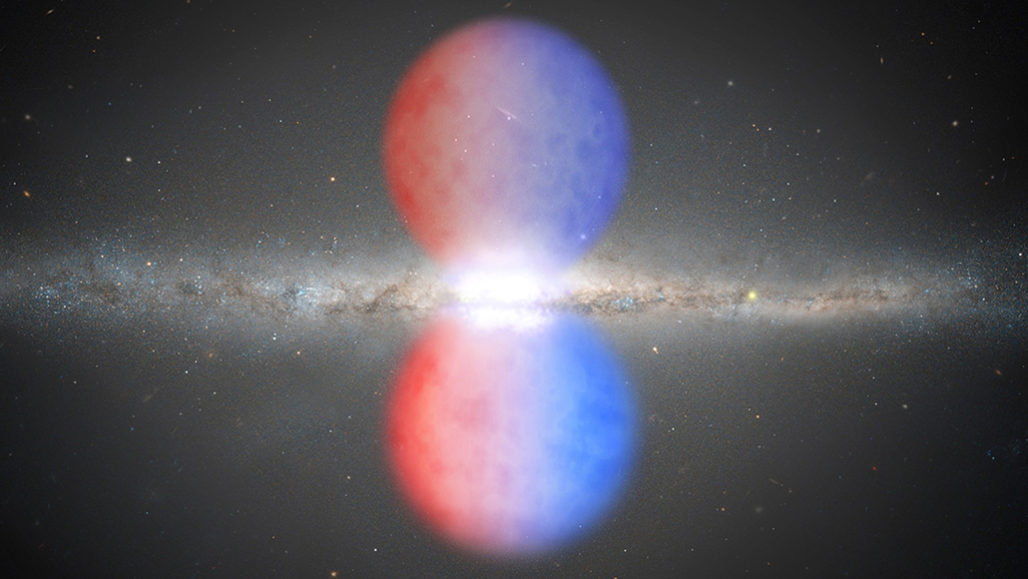Spotted: Milky Way’s giant gas bubbles in visible light
They’re called Fermi bubbles and a new technique could map how fast they move

Giant gas bubbles above and below the center of the Milky Way are illustrated here. The solar system is the bright, yellow spot at the right of the galaxy’s center. The gas moving toward the solar system looks bluer. Gas moving away from it appears redder.
HST/NASA, and A. Field/STScI
Mysterious cosmic bubbles are being seen in a new light.
For the first time, scientists have observed visible light from enormous blobs of gas that sandwich the pancake flat part of our Milky Way galaxy. They’re known as Fermi bubbles. Astronomers had seen the bubbles since 2010, but never directly. The light they emitted is in wavelengths the human eye can’t see. At least, it hadn’t been until now.
Astronomer Dhanesh Krishnarao works at the University of Wisconsin–Madison. He was part of a team that spotted a new visible-light glow from the bubbles. It comes from hydrogen gas inside the bubbles that was electrically charged, or ionized. That ionization made the gas glow in colors our eyes can see.
The researchers described the bubbles’ glow June 3 at a news conference at a virtual meeting of the American Astronomical Society. The team also discusses the bubbles’ glow in a paper posted May 29 at arXiv.org.
Looking at their structure, astronomers have been able to guess about how the bubbles formed. They think these are relics of an ancient outburst of gas from the galaxy’s center. For now, scientists don’t know its source. A black hole sits at the center of the galaxy. As it was messily gobbling up matter, the leftovers from that meal could have flowed out to make the bubbles. Another idea: The bubbles were from young stars that formed long ago. They could have emitted the gas as they were just starting to take shape.
Astronomers first detected the bubbles spewing gamma rays. That’s a type of super-high-energy light. From that light, astronomers calculated the bubbles are towering structures. Each is 25,000 light-years tall! That’s more than a hundred quadrillion miles tall.
The color of motion
While astronomers aren’t sure what made the bubbles, they now have a sense of what’s happening inside them. Gas within the bubbles is expanding outward. And that movement changes the color of the light emitted by the gas.
Light travels in waves. Those waves are sort of like waves at the beach. The distance between each crest, or tip, of a wave is its wavelength. In the bubbles, if the gas is moving toward us, the light’s waves get more bunched up, making the wavelengths shorter. Light from gas traveling away has waves that become more spread out. That makes the wavelengths longer.
Wavelengths of light correspond to colors we see. Longer wavelengths are red, shorter ones blue. Gas closer to the solar system is traveling toward it. So it looks bluer. More distant gas is moving away from the solar system. It looks redder.
Those colors are important. They allowed the researchers to pinpoint how fast the gas is moving in a particular direction. Tracking the colors, the team could measure the velocity of the gas at one location within the bubbles. To do this, the researchers used the Wisconsin H-Alpha Mapper telescope, or WHAM. Data from WHAM helped the team calculate that the gas was flowing away from the center of the bubbles at about 220 kilometers per second. That’s nearly half a billion miles per hour.
The estimate makes sense, the team says. It matches an earlier measurement made using ultraviolet light. Our eyes can’t see that light’s very short wavelengths.
Making the measurement in visible light offers more clues about the bubbles. Krishnarao and his colleagues now want to take measurements in other spots in the bubbles. This could help the astronomers better map out the velocity of the gas in there.
“What that can tell us is how, over time, the energy output from the Fermi bubbles has changed,” Krishnarao said. “That’ll really be able to nail down more about the origin.”







